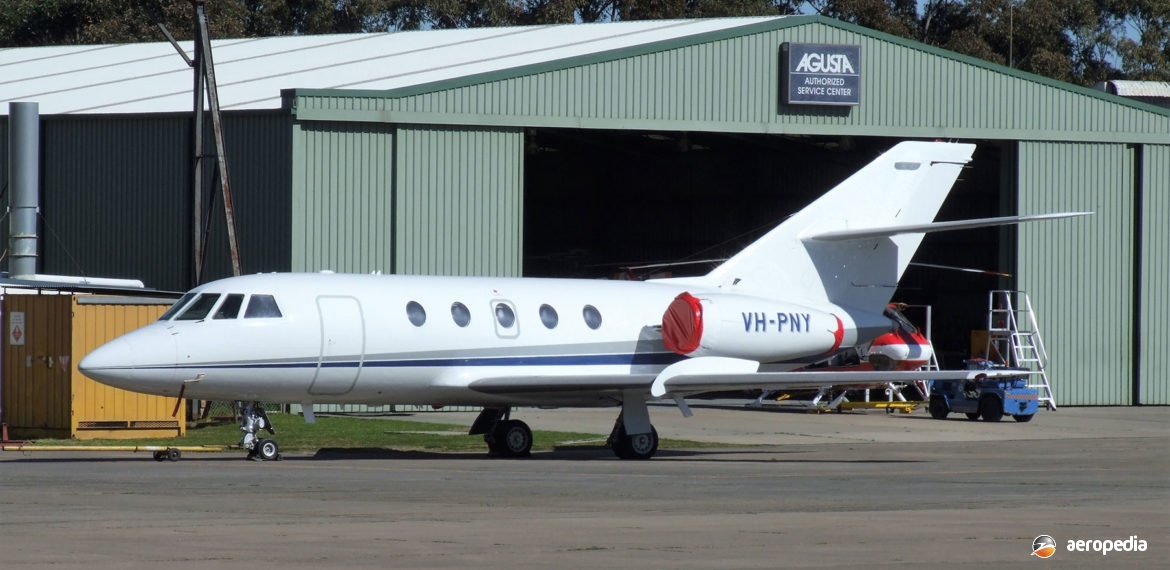Photograph:
Dassault-Breguet Falcon 20-F5 VH-PNY (c/nb 357) at Bankstown, NSW in August 2012 (David C Eyre)
Country of origin:
France
Description:
Business and executive aircraft
Power Plant:
Two 4,315 lbst General Electric CF700-2D-2 turbofans
Specifications:
- Wingspan: 16.3 m (53 ft 6 in)
- Length: 17.15 m (56 ft 3 in)
- Height: 5.32 m (17 ft 5 in)
- Wing area: 41 m² (441.33 sq ft)
- Max cruising speed at 7,620 m (25,00 ft): 862 km/h (536 mph)
- Economical cruising speed at 12,200 m (40,000 ft): 750 km/h (466 mph)
- Absolute ceiling: 12,800 m (42,000 ft)
- Range with max fuel: 3,570 km (2,230 miles)
- Empty weight: 7,240 kg (15,970 lb)
- Loaded weight: 13,000 kg (28,660 lb)
History:
In 1961 Dassault entered the business-jet market with the design of the Mystere, which was known as the Falcon in the USA. With accommodation for eight to ten persons, the first aircraft was powered by Pratt & Whitney JT12A-8 turbojets and was flown for the first time on 4 May 1963. Subsequently it was re-engined with General Electric turbofans, which then powered all production aircraft. The Business Jets Division of Pan American World Airways marketed the type in North America, and about two-thirds of all aircraft were produced for the American market.
The first of the type to be seen in Australia VH-BIZ (c/n 73) was obtained by Business Jets Pty Ltd in 1967. After being demonstrated at the Paris Air Show (as F-WJML), an attempt on the Paris to Melbourne record was made during the aircraft’s delivery flight but the aircraft was detained at Karachi for two days pending clearance to fly through India.
This aircraft VH-BIZ was a variant developed for Bizjets and was equipped with low-pressure tyres and a braking parachute to use on shorter runways. After some use on the company’s operations to Mt Tom Price and other mining towns, the aircraft was sold overseas.
Three Dassault-Breguet Falcon 20Cs (also known as the Mystere 20C) were purchased as VIP aircraft for the RAAF. These three aircraft A11-078 (c/n 78), A11-085 (c/n 85) and A11-090 (c/n 90) were attached to No 34 Squadron at RAAF Base, Fairbairn, ACT, and operated alongside two BAC 111s and two Hawker Siddeley HS-748s until replaced by Dassault-Breguet Falcon 900s. These aircraft later became VH-JSX, VH-JSY and VH-JSZ, the first two being exported as N6555C and N6555L, whereas VH-JSZ became VH-CIR with Pel Air before being exported to Christmas Island as PK-CIR.
A Falcon 20 was converted to be the prototype of the 200 series and it first flew on 30 April 1980. This series had greater fuel tankage and longer range, re-designed root fairings and some equipment changes.
Late in 1981 the Falcon 20 became known as the Falcon 200, the new designation for the Model 200H, this being a re-engined development. The Model 200 was powered by Garrett AiResearch ATF3-6-1C turbofans of 5,050 lbst, whereas all models up to the 20G (known as the HU-25A Guardian in US Coast Guard service) had been fitted with General Electric CF700 engines.
Production of the series ended in 1988 after 476 Series 20 and 38 Series 200 had been delivered.
At the time of publication some 21 examples of the 20 and 200 series had been registered in Australia, these including Falcon 20C, 20D, 20E and 20F models. Falcon 20 aircraft registered have included: VH-DWA (c/72); VH-BIZ (c/n 73); VH-FWO (c/110); VH-BRR (c/n 208); VH-FAX (c/n 247); VH-HIF/VH-MIQ (c/255); VH-WLH (c/n 262); VH-HFJ (c/n 306); VH-RRC (c/n 325); VH-NMN (c/n 327); VH-NCF (c/n 368); VH-HPF (c/n 391) and VH-FJZ (c/n 441).
Falcon 200s registered have included included: VH-PDJ/VH-HPJ (c/n 491); VH-ECG (c/n 493); VH-BGL (c/n 495); VH-CPE (c/504) which was exported in 2006 as N504FJ; and ZK-MAY (c/n 505) which later in September 1990 became VH-NGF before being exported as XA-SKO.

